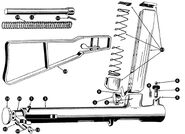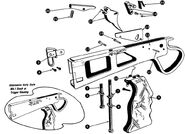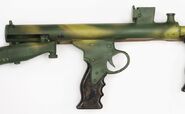The Owen machine carbine, colloquially known as the Owen gun, was an Australian submachine gun designed by Evelyn Owen, Vincent Wardell and Freddie Kunzler from 1931 to 1939 and produced from 1941 to 1945 by Lysaght's Works and the Lithgow Small Arms Factory. The only mass-production submachine gun designed entirely and manufactured by Australians, the Owen gun was a workhorse in the Australian Army serving well into the 1960s.
History[]
The weapon was designed by Evelyn Owen who at first designed a .22 LR SMG and shown to Australian Army ordnance officers and at first rejected for two reasons; The military did not find the use of SMGs important and the prototype was not compatible as a military weapon. The design never had a safety device/proper trigger and its magazine could not be removed for a fast reload during a firefight.
In 1940, Owen's neighbour Vincent Wardell (manager of a steel factory at Port Kembla) found the prototype in a sugar bag. Although distressed at leaving the prototype SMG unattended, he was impressed of the design's simplicity. Wardell then transferred Owen over to the Army Inventions Board. High-ranking Army officials still viewed the prototype in a bad light, but the Government took it in a favourable view.
The first .22 LR prototype used a cylinder made from a car part and wound from a gramaphone spring. This, however, gave the idea of a top inserted magazine, which would be used at this point and also allowed firing from a prone position.
The calibres avaliable for the later prototypes were 9×19mm Parabellum, .32 ACP and .45 ACP. Rival weapons in the trial were the Sten and Thompson submachine guns. During the trials, the SMGs were tested in harsh environments, the Owen turned out to function after testing. Although the Owen was the most capable, the Army was undecided about its calibre. The Government placed an order for the 9×19mm variant.
Overview[]
The Owen SMG is a 9mm calibre magazine-fed blowback-operated submachine gun. The magazine is inserted overhead and uses offset sights. The receiver has a section that separates the bolt from the cocking handle, preventing dirt from entering the receiver. If dirt did get into the weapon, it would congregate at the rear through a small drainage hole. The firing pin was machined into the face of the bolt. The ejector was built into the magazine.









